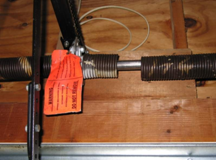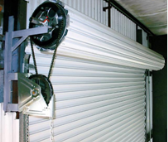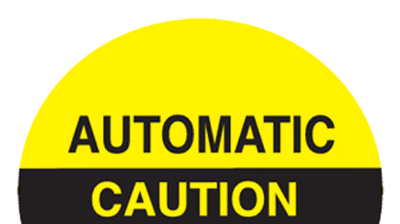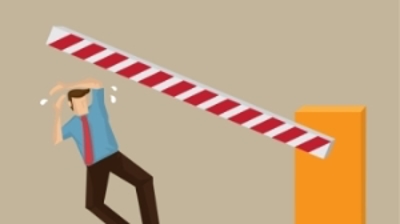GARAGE DOORS
A Brief Tutorial on
Garage Door Safety & Installation

By Michael Panish
Door Expert Witness & Consultant
Download PDF of this article here
As a door expert, I am called upon many times a year to evaluate garage door injuries. In my professional career as a general contractor and door & hardware contractor, I have installed many different types of garage doors. I have been involved with roll up doors, both for commercial warehouse applications and automotive repair facilities that allow the passage of a motor vehicle. I have installed and serviced life safety/fire drop doors typically seen in hospitals, pharmacies, labs, shopping centers and other commercial venues. I have placed sectional doors in apartment buildings, single family homes and condominiums. My company has custom built many types of garage enclosures that have had special cosmetic concealed purposes for themed attractions. Working on historic buildings has given me the opportunity to work on sliding barn type doors, hinged parting doors and old carriage style swinging doors. I have removed and replaced the older style, overhead vintage single panel pivoting hinged garage door from commercial and residential locations, and have installed a variety of newer and safer products.
Garage doors come in many shapes and sizes. Their functions range from basic security of an area to cosmetic concealment. Most doors can be broken down into a few basic styles or categories. Typical modern garage doors for residential applications tend to be predominantly of the overhead sectional variety. That style of door comes in many configurations, materials, levels of insulation, and a wide range of appearance possibilities. They are available as a prefabricated kit, or built as a custom design to complement the décor of any building. Commercial warehouse type installations often dictate higher security requirements. A good choice for this security type of door is the "roll-up" style that resembles a roll top desk type of door. This door can be manufactured with a variety of materials that can be as strong as the adjacent walls, making forced entry through this opening very difficult. Other common commercial installations include light weight aluminum single or sectional panel doors. These doors function more for closing off an already secured area than for assuring point security.
In the past, the biggest concern with operating an overhead garage door was the potential risks associated with the springs used for balancing the door weight. Pre mid 1960's garage door installations typically relied upon a pair of stretched (tensioned) springs to assist the operation of the garage door pivoting hinges. These springs became loaded (tensioned) as the door was moved into the closed position. Unloading (releasing) of the stored spring energy occurred as the door was opened to the horizontal overhead position. One of the most dangerous aspects of these spring systems was that after a period of time, often without any maintenance or inspection, the points of attachment of these springs would rust or become weak. This weakening of the springs or points of attachment would often lead to an inadvertent explosive failure flinging the broken spring components across the garage, embedding the spring or steel components into the garage walls, cars or other items in the path of travel. Unfortunately, sometimes people were in the path of travel of these explosive occurrences. As these springs failed, as an attempted safeguard, some manufacturers devised a "caging" system for the springs. These cages were retrofitted onto the stretched springs in an attempt to capture the parts that would release if a failure occurred. While these caging devices were helpful, they were not completely effective. Some of these spring devices are still in use today. Whenever this condition exists or the quality of garage components are questionable, a qualified professional service technician should be consulted.
In response to the inherently dangerous old style garage spring issues as above, a newer and safer system for opening the overhead garage door was created. The idea was to transfer the load or weight of the door via a cable and pulley system to a vertical rod now equipped with a torsion (twisted) spring. This type of spring is installed with specialty hardware and bolts to a fixed plate at one end, while the entire spring is installed around a horizontal pipe. This load balancing device is normally installed directly over the header of the garage opening. Using appropriate cables, connectors and pulleys, the weight of the garage door is transferred into the torsion spring system. The difference between the old style stretched spring and the newer torsion spring is the way that the spring energy is stored. With the old style stretched spring, the energy is stored and released by pulling on the spring or returning the spring to its un-stretched condition. With a torsion type of spring, the energy is imparted or removed by rotating the spring clockwise or counter clockwise depending upon the direction of usage. With professional installation, the complete loading of the torsion spring is controlled by the garage installer, and is determined by the weight and size of the garage door that it is operating. When this type of torsion spring fails, it remains attached and intact to the location on the horizontal control rod where it was mounted. I have not heard of or seen any torsion spring fly across a garage, creating injury from failed components as with the stretched older style garage door springs. This is not to say that injuries have not occurred with the torsion style spring. The installation of this type of spring is generally safe when left to a trained garage door installation professional. Severe and serious injuries have occurred when untrained, unqualified individuals have attempted to install or service this type of spring. In most installations, a warning tag is left attached adjacent to the torsion spring when the garage door is installed.

Warning tag installed adjacent to torsion spring. Spring to left of tag is still in tension;
Spring to right of tag is broken and shows how the rod captures a torsion spring when it fails.
This tag warns of the danger associated with the stored energy of this spring, and alerts untrained individuals to not attempt any repair, adjustment or to even touch the spring and associated hardware. When the label that should be attached to this spring becomes damaged, is removed or tampered with, it is important that a new warning label be reattached immediately to show the dangers of this spring tension
Garage doors can be operated manually (by hand), as well as automatically (by power assisted motor). In both cases, the proper operation of the garage door is determined by the proper balancing of the garage door weight, springs and related component hardware. An automatic power assisted motor cannot overcome an improperly balanced garage door. The weight of all garage doors is normally deceptive. Due to the fact that a properly functioning door appears easy to open and close, many users do not realize the combined overall weight until springs fail to assist the door in its operation. In all cases, regardless of the type of garage door, the entire system of hinges, track, hardware, and door opener work as a team. Problems with misalignment, shifting, or jamming can lead to problematic operation of a door. Counter forces imparted to a garage door, not engineered into the components, can lead to injury. Inappropriate maintenance or complete lack of maintenance has lead to severe bodily injuries. Forcing the operation of a garage door, when one or more components have become damaged or broken has lead to serious bodily injuries. In all cases, maintenance is a crucial and important aspect of proper operation of all door systems.
In contrast to an overhead type of garage door, be it sectional or single panel, roll up doors have a totally different type of operating system. When these doors are used, they can be concealed in an overhead or under mounted trough. These doors operate similarly to a roll top desk door except for how they are stored when not in the closed position. They normally coil as they are retracted, and require significant gear trains to reduce the effort required to move these doors up and down into position. Often the forces needed to move these roll up doors require a reduction type of transmission that allows a very heavy door to be operated effortlessly. These doors can be chain driven either manually, or can be automated using electric motors. Roll up doors require more frequent evaluation and servicing than a standard overhead garage door. The tracks that are mounted vertically on both sides of the garage opening need maintenance and cleaning more frequently, and are often blocked by foreign obstructions or damaged by collision of some type. These roll up doors are often held open by some type of ratcheting action. Proper balancing of these doors is often more important than an overhead type of door, as the weight of these type of doors is normally much greater than an overhead door.

Roll up door showing gearing and pulley method for manual opening & closing
(no trough or shroud enclosure on this photo)
I have been involved in numerous garage door cases where many different reasons for an injury have occurred. Having been retained as expert witness for both plaintiff and defense, several common factors have been observed. In many cases, unqualified individuals have attempted to repair or install garage doors. They have lacked the knowledge, skills or even the basic required tools to perform the work safely and properly. I have been hired as an expert by garage door manufacturers and installers to defend claims that they are not responsible for alleged product defects. In most cases, the components that failed, failed as a result of abuse or improper installation on the part of the end user. As stated above, the installation of many garage doors is not appropriate for an untrained person. An exception to this relates to "do it yourself" garage door kits that are sold at local home centers. A homeowner could install the door because these kits do not come with a professional quality package of hardware that should or would require special knowledge for the installation. These kits do not typically employ torsion springs that would require special knowledge, proper tools, and working skills to install. The doors are typically for light duty use. Professional installation services are often available through a home center to assist a homeowner in need of a specialized installation. As with most trade specific tasks, years of experience working as a professional installer qualifies tradesmen for their contracting license. The average homeowner watching a few television shows that give rough explanations of how to install garage doors is not usually qualified to install his or her own door. These "how to" television shows are no substitute for the many skills acquired after working in the field.
The above article is a very brief description of a few types of garage doors. Photos in this article are non specific and were meant for illustrative purposes only. I have not given any specific details regarding appropriate trade conduct or listed any information regarding the potential for serious bodily injuries.
Mike Panish is a forensic expert witness and consultant in the construction industry. One of his primary areas of expertise pertains to doors and automatic door cases. He has over 35 years of hands on experience dealing with commercial, multi residential, hotel, hospital, lab and other locations where specialty door systems are needed. He has written many articles on the subject of door related claims and maintenance issues related to door and automatic door systems. He is licensed as a door and hardware contractor in the State of California. He has been involved in door cases across the United States and has been involved in both forensic analysis, case investigation, and has consulted on many garage door related injury claims. He has been used as a consultant and has been retained and designated as expert in many types of door injury related claims for both the plaintiff and defense,and is the most retained expert for door related injuries for both plaintiff and defense. Mike is able to quickly ascertain the facts, explain the critical information pertaining to your case and can assist you in developing your case from discovery through trial. He has offices in California, New Hampshire and Massachusetts. He is available for nationwide, inspection, consulting, expert analysis, and testimony.
Michael Panish can be reached at (888) 902-4272 (Ask for Sharon). email: Expert@ConstructionWitness.com
Visit www.ConstructionWitness.com for more information about Michael Panish's services.



